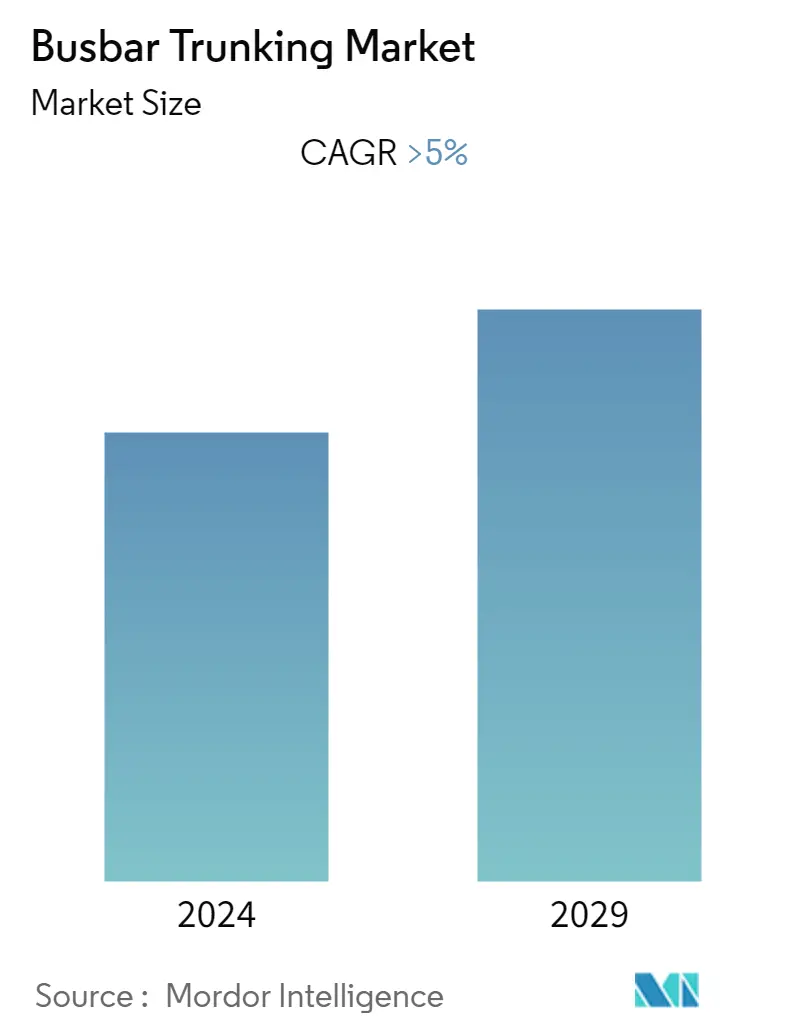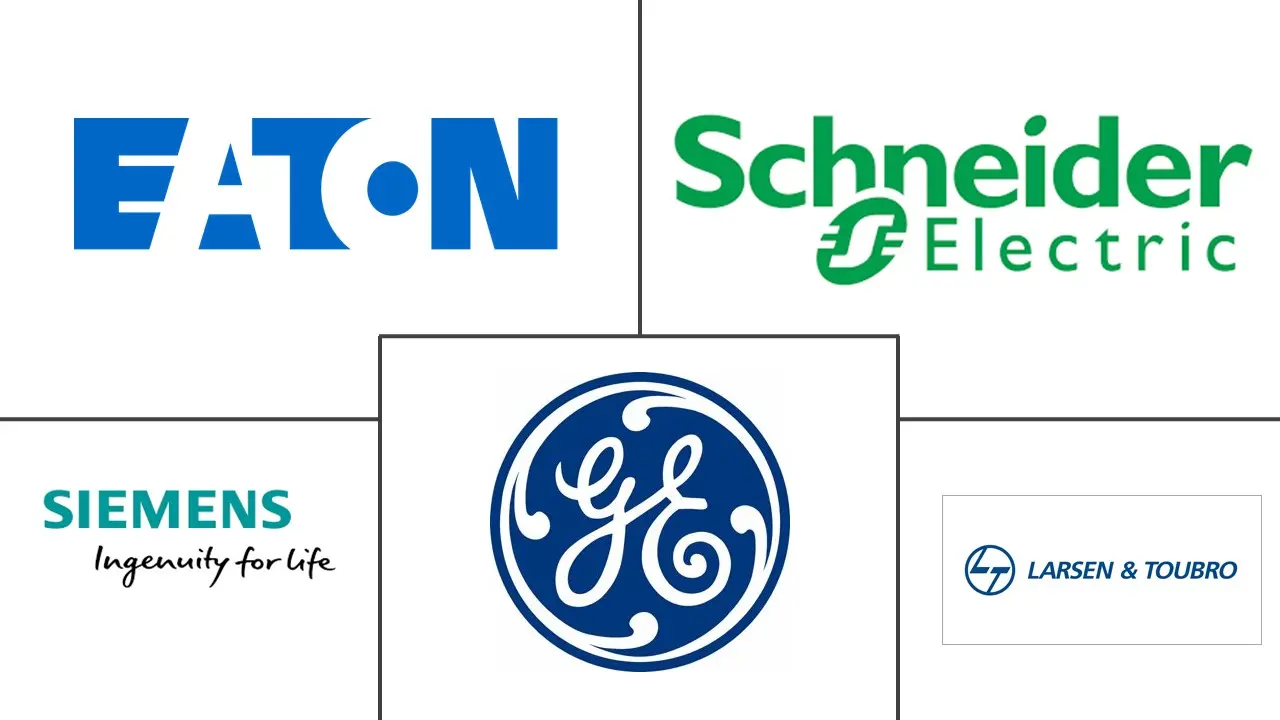Market Size of Busbar Trunking Industry

| Study Period | 2021 - 2029 |
| Base Year For Estimation | 2023 |
| CAGR | 5.00 % |
| Fastest Growing Market | Asia Pacific |
| Largest Market | Asia Pacific |
| Market Concentration | High |
Major Players
*Disclaimer: Major Players sorted in no particular order |
Busbar Trunking System Market Analysis
The busbar trunking market is expected to grow at a CAGR of more than 5% over the forecast period (2022-2027).
The market was negatively impacted by the Covid-19 pandemic, as many industrial projects were stalled due to the unfavourable economic atmosphere. However, the market has since rebounded, and the market is expected to grow steadily during the forecast period.
- Factors such as an increase in power consumption and technical advantages of busbar trunking, especially in the industrial sector, are expected to drive the market during the forecast period.
- On the flip side, the high cost of busbar trunking systems, making them unviable for small and medium enterprises is likely to restrain the growth of the busbar trunking market in the coming years.
- However, globally, the focus has increased on investments in clean energy projects and the development of smart cities. As a result, the extensive development of new renewable projects and the development of green constructions are likely to create an excellent opportunity for the busbar trunking market in the future.
Busbar Trunking System Industry Segmentation
Busbar Trunking System distributes electric power using copper or aluminum busbars with suitable enclosures and a good amount of protection to prevent the cables from getting damaged due to foreign bodies. The busbar trunking market is segmented by Material, Power Rating, End-User, and Geography. By Material, the market is segmented into Aluminum and Copper. By Power Rating, the market is segmented into Lighting, Low Voltage, Medium Voltage, and High Voltage. By End-user, the market is segmented into Commercial, Industrial, Transportation, and Residential. By Geography, the market is segmented into North America, Europe, Asia-Pacific, South America, and Middle-East, and Africa. For each segment, the market sizing and forecasts have been done based on revenue (USD Billion).
| Material | |
| Aluminum | |
| Copper |
| Power Rating | |
| Lighting | |
| Low Voltage | |
| Medium Voltage | |
| High Voltage |
| End-User | |
| Commercial | |
| Industrial | |
| Transportation | |
| Residential |
| Geography | |
| North America | |
| Europe | |
| Asia-Pacific | |
| South America | |
| Middle-East and Africa |
Busbar Trunking Market Size Summary
The busbar trunking system market is poised for steady growth over the forecast period, driven by increasing power consumption and the technical advantages these systems offer, particularly in the industrial sector. Despite the initial setbacks caused by the Covid-19 pandemic, which stalled numerous industrial projects, the market has rebounded and is expected to expand. The industrial sector is anticipated to dominate the market due to the rising adoption of energy efficiency practices and government mandates aimed at reducing electricity consumption. However, the high cost of busbar trunking systems may pose a challenge for small and medium enterprises, potentially restraining market growth. Nonetheless, the global focus on clean energy investments and smart city developments presents significant opportunities for the busbar trunking market.
Asia-Pacific is projected to be the fastest-growing region in the busbar trunking market, fueled by rapid urbanization, industrialization, and a burgeoning population. The region's substantial energy market, led by China and India, is witnessing significant investments in renewable energy and transmission infrastructure to meet the high demand for a reliable power supply. Both countries hold a significant share of the world's industrial sector, particularly in energy-intensive manufacturing, which is expected to drive the demand for busbar trunking systems. The market is highly fragmented, with key players such as Larsen & Toubro Limited, Eaton Corporation PLC, General Electric Company, Schneider Electric SE, and Siemens AG. Recent strategic moves, like Vertiv Holdings Company's acquisition of E&I Engineering Ireland and Powerbar Gulf, highlight the competitive landscape and ongoing consolidation efforts within the market.
Busbar Trunking Market Size - Table of Contents
-
1. MARKET OVERVIEW
-
1.1 Introduction
-
1.2 Market Size and Demand Forecast in USD billion, till 2027
-
1.3 Recent Trends and Developments
-
1.4 Government Policies and Regulations
-
1.5 Market Dynamics
-
1.5.1 Drivers
-
1.5.2 Restraints
-
-
1.6 Supply Chain Analysis
-
1.7 Porter's Five Forces Analysis
-
1.7.1 Bargaining Power of Suppliers
-
1.7.2 Bargaining Power of Consumers
-
1.7.3 Threat of New Entrants
-
1.7.4 Threat of Substitutes Products and Services
-
1.7.5 Intensity of Competitive Rivalry
-
-
-
2. MARKET SEGMENTATION
-
2.1 Material
-
2.1.1 Aluminum
-
2.1.2 Copper
-
-
2.2 Power Rating
-
2.2.1 Lighting
-
2.2.2 Low Voltage
-
2.2.3 Medium Voltage
-
2.2.4 High Voltage
-
-
2.3 End-User
-
2.3.1 Commercial
-
2.3.2 Industrial
-
2.3.3 Transportation
-
2.3.4 Residential
-
-
2.4 Geography
-
2.4.1 North America
-
2.4.2 Europe
-
2.4.3 Asia-Pacific
-
2.4.4 South America
-
2.4.5 Middle-East and Africa
-
-
Busbar Trunking Market Size FAQs
What is the current Busbar Trunking Market size?
The Busbar Trunking Market is projected to register a CAGR of greater than 5% during the forecast period (2024-2029)
Who are the key players in Busbar Trunking Market?
Larsen & Toubro Limited, Eaton Corporation PLC , General Electric Company , Schneider Electric SE and Siemens AG are the major companies operating in the Busbar Trunking Market.

